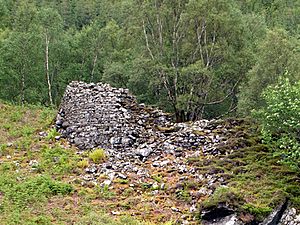Dun Grugaig facts for kids

Dun Grugaig viewed from the east
|
|
| Location | Scottish Highlands |
|---|---|
| Coordinates | 57°11′01″N 5°33′25″W / 57.183555°N 5.556823°W |
| Type | Broch |
| History | |
| Periods | Iron Age |
Dun Grugaig (also called Caisteal Chonil) is an ancient stone fort in Scotland. It's a special type of fort known as a "semi-broch" because it shares features with both simple forts (duns) and tall, round towers (brochs). You can find it about 7 kilometres southeast of a village called Glenelg, Highland.
Contents
What is Dun Grugaig?
Dun Grugaig is an old stone building from the Iron Age. It's shaped like the letter "D" and is sometimes called a "dun" or a "semi-broch." This means it's an early kind of broch, which were strong stone towers built by people long ago in Scotland. It has thick walls that are hollow inside, a common feature of later, more advanced brochs.
Where is Dun Grugaig Located?
Dun Grugaig sits in a beautiful valley called Gleann Beag, near the Abhainn a’Ghlaine Bhig river. This valley is famous because it's also home to two other well-known brochs: Dun Telve and Dun Troddan. While those two brochs are on flat ground, Dun Grugaig is built on higher, rougher land. It's important not to mix it up with another broch called Caisteal Grugaig, which is a few miles north.
What Does Dun Grugaig Look Like?
This ancient fort is shaped like a "D." The straight part of the "D" faces a steep drop on the east side. The whole building measures about 17 metres long and 12 metres wide. Its walls are built with a special "hollow-wall" design. This means there are spaces or passages inside the thick stone walls.
Entrances and Inside
The main way into Dun Grugaig seems to be through a doorway on the southeast side. This entrance has a stone beam, called a lintel, over the top. There's also another entrance at the west end of the wall. Today, the inside of the fort is mostly filled with fallen stones and debris. If you look closely, you can see traces of three doorways in the inner wall. High up on the south side, you can even spot parts of an upper passage or gallery built within the wall itself.
Who Discovered Dun Grugaig?
Archaeologists have not yet dug up Dun Grugaig to learn more about it. The earliest mention of this fort was in 1720 by a man named Alexander Gordon. He called it 'Castle Chonil' and noted it was different from the other two brochs in the valley. Later, in 1871, Henry Dryden made the first detailed measurements and drawings of Dun Grugaig.


